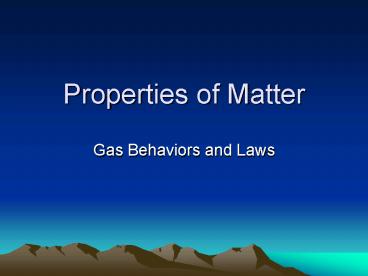Properties of Matter - PowerPoint PPT Presentation
1 / 9
Title:
Properties of Matter
Description:
The space that gas particles occupy is the gas's volume, which can change ... Imagine that a diver 10m below the surface of a lake blows a bubble of air. ... – PowerPoint PPT presentation
Number of Views:130
Avg rating:3.0/5.0
Title: Properties of Matter
1
Properties of Matter
- Gas Behaviors and Laws
2
Gases
- Gases behave differently than solids or liquids.
- Unlike the particles that make up solids and
liquids, gas particles have a large amount of
empty space between them. - The space that gas particles occupy is the gass
volume, which can change because of temperature
and pressure. - http//www.chemistry.ohio-state.edu/betha/nealGasL
aw/fr1.1.html - http//www.chemistry.ohio-state.edu/betha/nealGasL
aw/fr1.2.html
3
Gas-Temperature
- Temperature is a measure of how fast the
particles in an object are moving. - The faster the particles are moving, the more
energy they have. - Therefore, the gas is expanding.
- The slower the particles are moving, the less
energy they have.
4
Gas- Volume
- Volume is the amount of space that an object
takes up. - Since the particles of a gas spread out, the
volume of any gas depends on the container that
the gas is in. - Example, inflated balloons that are twisted into
different shapes. Shaping the balloons was
possible because particles of gas can be
compressed, or squeezed together into a smaller
volume.
5
Gas- Pressure
- Pressure is the amount of force exerted on a
given area of surface. - Another way to think of pressure is to think of
it as the number of times the particles of a gas
hit the inside of their container. - When more particles hit the inside surface of a
basketball, the force on the inside surface of
the ball increases. This increased force leads to
greater pressure, which makes the basketball feel
harder than a beach ball.
6
Gas Behavior Laws
- Scientists have found that the temperature,
volume, and pressure of a gas are linked. - Changing one of the factors changes the other two
factors. - The relationship between temperature, volume, and
pressure are described by gas laws.
7
Gas Laws
- Imagine that a diver 10m below the surface of a
lake blows a bubble of air. When the bubble
reaches the surface, the bubbles volume has
doubled. - The difference in pressure between the surface
and 10m below the surface caused this change.
8
Gas Laws
- The relationship between the volume and pressure
of a gas was first described by Robert Boyle
(1627-1691). - Boyles Law- the volume of a gas is inversely
proportional to the pressure of a gas when
temperature is constant. - As the pressure increases the volume decreases
(at constant temperature).
9
Gas Laws
- If you blow air into a balloon and leave it in
the hot sun, the balloon might pop! - Jacques Charles (1742-1823) created Charles Law.
- Charles Law- the volume of a gas is directly
proportional to the temperature of a gas when
pressure is constant. - If the temperature increases the volume also
increases (at constant pressure).































